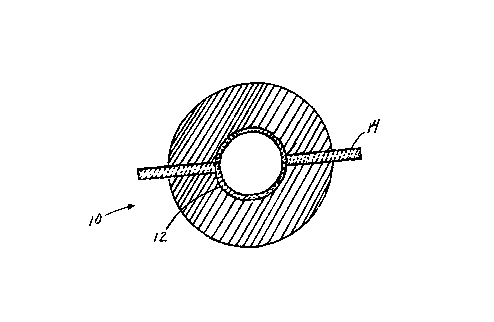Une partie des informations de ce site Web a été fournie par des sources externes. Le gouvernement du Canada n'assume aucune responsabilité concernant la précision, l'actualité ou la fiabilité des informations fournies par les sources externes. Les utilisateurs qui désirent employer cette information devraient consulter directement la source des informations. Le contenu fourni par les sources externes n'est pas assujetti aux exigences sur les langues officielles, la protection des renseignements personnels et l'accessibilité.
L'apparition de différences dans le texte et l'image des Revendications et de l'Abrégé dépend du moment auquel le document est publié. Les textes des Revendications et de l'Abrégé sont affichés :
| (12) Demande de brevet: | (11) CA 2211952 |
|---|---|
| (54) Titre français: | BOULETS CREUX MOULES RESISTANT A L'ABRASION |
| (54) Titre anglais: | CAST ABRASION RESISTANT HOLLOW BALLS |
| Statut: | Réputée abandonnée et au-delà du délai pour le rétablissement - en attente de la réponse à l’avis de communication rejetée |
| (51) Classification internationale des brevets (CIB): |
|
|---|---|
| (72) Inventeurs : |
|
| (73) Titulaires : |
|
| (71) Demandeurs : |
|
| (74) Agent: | SMART & BIGGAR LP |
| (74) Co-agent: | |
| (45) Délivré: | |
| (22) Date de dépôt: | 1997-07-29 |
| (41) Mise à la disponibilité du public: | 1999-01-29 |
| Requête d'examen: | 1999-05-31 |
| Licence disponible: | S.O. |
| Cédé au domaine public: | S.O. |
| (25) Langue des documents déposés: | Anglais |
| Traité de coopération en matière de brevets (PCT): | Non |
|---|
| (30) Données de priorité de la demande: | S.O. |
|---|
Boulet creux moulé résistant à l'abrasion formé à l'aide d'un noyau de céramique creux qui ne produit aucun gaz pendant le moulage. Des barres de céramique ou des supports maintiennent le noyau de céramique creux à une position fixe au centre du boulet moulé pendant le moulage. Il n'y a ni trous ni ouvertures dans les supports de céramique étant donné que la sphère de céramique creuse est composée d'un matériau réfractaire inerte qui élimine les gaz produits pendant la coulée et la solidification du métal liquide pendant le moulage.
A cast abrasion resistant hollow ball is formed with
a hollow ceramic core that generated no gas during the
casting operation. Solid ceramic bars or supports hold the
hollow ceramic core in a fixed location at the center of
the cast ball during the casting process. There are no
open holes or openings in the ceramic supports due to the
fact that the hollow ceramic sphere is composed of an inert
refractory material which eliminates any gases being
generated during the pouring and solidification of the
liquid metal in the casting process.
Note : Les revendications sont présentées dans la langue officielle dans laquelle elles ont été soumises.
Note : Les descriptions sont présentées dans la langue officielle dans laquelle elles ont été soumises.

2024-08-01 : Dans le cadre de la transition vers les Brevets de nouvelle génération (BNG), la base de données sur les brevets canadiens (BDBC) contient désormais un Historique d'événement plus détaillé, qui reproduit le Journal des événements de notre nouvelle solution interne.
Veuillez noter que les événements débutant par « Inactive : » se réfèrent à des événements qui ne sont plus utilisés dans notre nouvelle solution interne.
Pour une meilleure compréhension de l'état de la demande ou brevet qui figure sur cette page, la rubrique Mise en garde , et les descriptions de Brevet , Historique d'événement , Taxes périodiques et Historique des paiements devraient être consultées.
| Description | Date |
|---|---|
| Inactive : CIB de MCD | 2006-03-12 |
| Inactive : CIB de MCD | 2006-03-12 |
| Inactive : CIB de MCD | 2006-03-12 |
| Inactive : CIB de MCD | 2006-03-12 |
| Le délai pour l'annulation est expiré | 2001-07-30 |
| Demande non rétablie avant l'échéance | 2001-07-30 |
| Réputée abandonnée - omission de répondre à un avis sur les taxes pour le maintien en état | 2000-07-31 |
| Requête d'examen reçue | 1999-05-31 |
| Toutes les exigences pour l'examen - jugée conforme | 1999-05-31 |
| Lettre envoyée | 1999-05-31 |
| Exigences pour une requête d'examen - jugée conforme | 1999-05-31 |
| Demande publiée (accessible au public) | 1999-01-29 |
| Modification reçue - modification volontaire | 1997-11-19 |
| Symbole de classement modifié | 1997-11-05 |
| Inactive : CIB attribuée | 1997-11-05 |
| Inactive : CIB en 1re position | 1997-11-05 |
| Inactive : CIB attribuée | 1997-11-05 |
| Exigences de dépôt - jugé conforme | 1997-10-10 |
| Inactive : Certificat de dépôt - Sans RE (Anglais) | 1997-10-10 |
| Lettre envoyée | 1997-10-08 |
| Demande reçue - nationale ordinaire | 1997-10-07 |
| Date d'abandonnement | Raison | Date de rétablissement |
|---|---|---|
| 2000-07-31 |
Le dernier paiement a été reçu le 1999-05-25
Avis : Si le paiement en totalité n'a pas été reçu au plus tard à la date indiquée, une taxe supplémentaire peut être imposée, soit une des taxes suivantes :
Veuillez vous référer à la page web des taxes sur les brevets de l'OPIC pour voir tous les montants actuels des taxes.
| Type de taxes | Anniversaire | Échéance | Date payée |
|---|---|---|---|
| Taxe pour le dépôt - générale | 1997-07-29 | ||
| Enregistrement d'un document | 1997-07-29 | ||
| TM (demande, 2e anniv.) - générale | 02 | 1999-07-29 | 1999-05-25 |
| Requête d'examen - générale | 1999-05-31 |
Les titulaires actuels et antérieures au dossier sont affichés en ordre alphabétique.
| Titulaires actuels au dossier |
|---|
| THE BABCOCK & WILCOX COMPANY |
| Titulaires antérieures au dossier |
|---|
| BRYAN HAND |